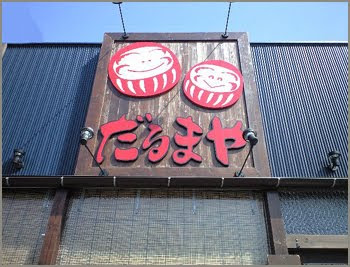:::::::::::::::::::::::::::::::::::::::::::::::::::::::::::::::::::::::::::::::::::::::::::::::::::::
Daruma Pilgrims Gallery
:::::::::::::::::::::::::::::::::::::::::::::::::::::::::::::::::::::::::::::::::::::::::::::::::::::
Billboard architecture
看板建築 kanban kenchiku
signboard architecture

ISBN 4385412146, Sanseido, 1988
This naming goes back to the architect Fujimori Terunobu
藤森照信 (1946 - ), who wrote a famous book about it, published in 1988.
The whole flat front of a house was used as a "signboard" (kanban).
Also called "imitating Western Style Architecture" giyoofuu kenchiku 擬洋風建築.
Most of these builings have been constructed after the great Kanto Earthquake in 1932. The influence of Western architecture had been there, and townsfolk were looking for fireproof material.
Before the earthquake, shops used to have large and wide boards (dashigeta 出桁) between two housed to prevent flames from a neighbour home to leap over. These boards protruded into the road and were abolished when new homes along city roads were to be constructed.
So they would construct the front of the store cum living quarters 店舗兼住宅, facing the road, in a different material from the house hidden behind it. It is kind of a "potempkin village" (: Something that appears elaborate and impressive but in actual fact lacks substance).

Most often mortar モルタル was used, often grafted in patterns of Greek temples with impressive classical pillars and gables. Others had the look of Art Nouveau decorations. This draws heavily on the art of the shakansan 左官, the wall plasterers of Edo.

Others used copper plates and boards, which were quite shining when newly build, but put on patina over the years. The patterns of the copper tiles could be quite elaborate, since the craftsmen used old Edo patterns for the wall decorations. This took time to prepare, but rich shop owners found an outlet to show their individuality.
Some of these shops have been designated as important cultural property, under protection.

. Reference : 看板建築
:::::::::::::::::::::::::::::::::::::::::::::::::::::::::::::::::::::::::::::::::::::::::::::::::::::
Town Houses of Kyoto, Kyoto Machiya 京都町屋
They are now being reconstructed as best as can.
Some are popular with foreigners, functioning as cheap lodgings.

. machiya tenugui 町家手拭
from the town houses of Kyoto
and some Daruma tenugui towels
. Kyoto Machiya Reference
traditionelle Stadthäuser
:::::::::::::::::::::::::::::::::::::::::::::::::::::::::::::::::::::::::::::::::::::::::::::::::::::
. 岡本一銭屋 "Okamoto One Cent Store"
My visit to Yonago Town

. Kanban, Shop Signs, 看板 Kamban
. shakan 左官 plasterer, stucco master .
Daruma Pilgrims in Japan
:::::::::::::::::::::::::::::::::::::::::::::::::::::::::::::::::::::::::::::::::::::::::::::::::::::






No comments:
Post a Comment